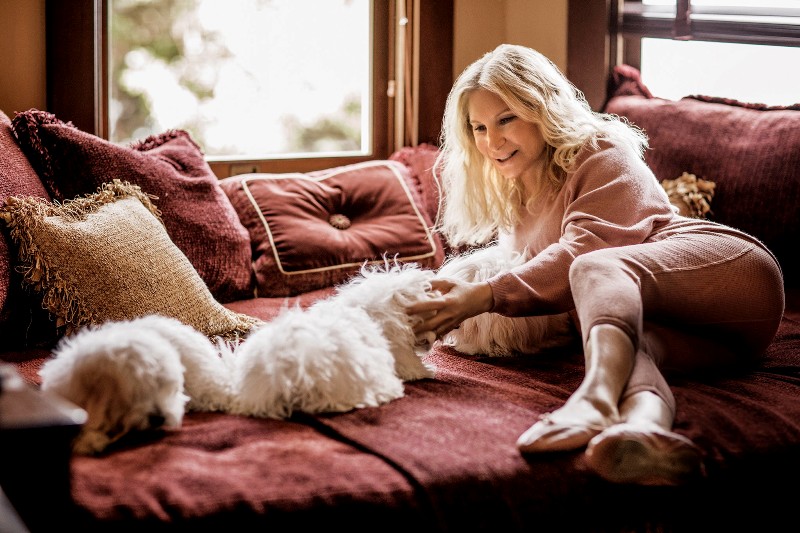

Singer Barbara Streisand
clones her deceased dog
IN THE ODDITIES ARCHIVES
Cereal
Donald Trump Look-Alike
A Real Killer Clown
New Dinosaur
Elisa Lam
Secret Room
Animal Thieves

The original dog Samantha (above)

Two new dogs cloned from Samantha (above)
Twice as nice - Barbra Streisand cloned her beloved dog
LOS ANGELES (Reuters) - “If we had the chance to do it all again, tell me would we, could we?” Barbra Streisand had a hit singing this question in “The Way We Were,” but when it comes to getting a new pet, she does not have to wonder.
The “Funny Girl” singer and actress had her beloved 14-year-old Coton de Tulear dog Samantha cloned after her death in 2017, and now has two new pups.
Streisand told Hollywood trade publication Variety in an interview published on Tuesday that cells were taken from the mouth and stomach of Samantha.
She said, "I was so devastated by the loss of my dear Samantha, after 14 years together, that I just wanted to keep her with me in some way. It was easier to let Sammie go if I knew I could keep some part of her alive, something that came from her DNA. A friend had cloned his beloved dog, and I was very impressed with that dog. So Sammie’s doctor took some cells from inside her cheek and the skin on her tummy just before she died. And we sent those cells to ViaGen Pets in Texas. We weren’t even sure if the cells would take."

Barbra Streisand revealed in an interview that two of her three Coton de Tulears had been cloned from her beloved late dog Samantha, who died last year at the age of 14. Credit: Russell James for Variety
What if you want to clone your dog?
If the possibility of cloning your dog intrigues you, there is good news: You do not have to be an incredibly famous and highly acclaimed actor, director, producer or writer to have it done.
You do, however, need money. But first, a little context.
We can clone dogs? Since when?
Even if you are not a close follower of clones, you may recall Dolly the Sheep, who was born in 1996. Since then, researchers have cloned about two dozen other mammal species, including cattle, deer, horses, rabbits, cats, rats — and yes, dogs.
South Korean researchers announced that they had cloned a dog for the first time in 2005, after almost three years of work and more than 1,000 eggs. With help from a yellow Labrador retriever who served as the surrogate mother, a cloned male Afghan hound named Snuppy was born. (Snuppy, of course, stood for “Seoul National University puppy.”)
By 2008, a California company had partnered with a South Korean laboratory and made plans to auction off chances to clone five dogs. Later that year, The New York Times reported that the first three puppies from the group had been born in South Korea.
Two 2015 reports — from Business Insider and NPR — detail the work of Sooam Biotech, a lab in South Korea, and said the lab, on its own, had cloned more than 600 dogs.
How much does it cost?
Both articles say Sooam Biotech charged about $100,000 to attempt the process. ViaGen Pets, a company based in Texas, says it charges $50,000 for the cloning or $1,600 to merely preserve your pet’s genes.
Reports and information on ViaGen’s website suggest that the cloning process — specifically a dog’s pregnancy — usually takes about 60 days.
It was not clear which company Ms. Streisand used to create her clones. A publicist for Ms. Streisand did not immediately respond to an email or phone message on Tuesday night.
See more HERE

The very first cloned animal was Dolly, the sheep (above)
Dolly was born on 5 July 1996 and had three mothers: one provided the egg, another the DNA, and a third carried the cloned embryo to term. She was created using the technique of somatic cell nuclear transfer, where the cell nucleus from an adult cell is transferred into an unfertilized oocyte (developing egg cell) that has had its cell nucleus removed. The hybrid cell is then stimulated to divide by an electric shock, and when it develops into a blastocyst it is implanted in a surrogate mother. Dolly was the first clone produced from a cell taken from an adult mammal.
A Finn Dorset breed such as Dolly has a life expectancy of around 11 to 12 years, but Dolly only lived 6.5 years.
Do cloned animals have shorter lives than the “real deal?”
Cloned Mice Have Shorter Life Expectancy, Study Says.
In the latest report concerning the health of cloned animals, Japanese scientists have found that cloned mice seem to have a shortened life span as a result of compromised immunity. Of 12 mice that were cloned, 10 died before reaching 800 days.
See more HERE